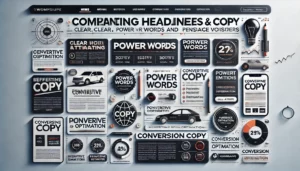Boost Your Sales: Proven Strategies to Optimise Website for Conversions

Boosting your conversion rate is essential for the success of your business. By implementing the five proven strategies to optimise website for conversions outlined in this article, you can craft compelling copy, utilise persuasive design elements, implement effective CTAs, and leverage social proof to drive real results. Remember to measure and track your conversion rate to continuously improve.
Key Takeaways
- Craft compelling headlines and copy to grab visitors’ attention and encourage exploration.
- Design your website with user experience in mind by simplifying navigation and enhancing visual appeal.
- Implement effective calls to action (CTAs) by strategically placing them and designing attractive CTA buttons.
- Leverage social proof through customer testimonials, case studies, and user-generated content to build trust.
- Utilise data and analytics to track conversion rates, analyse user behaviour, and make data-driven decisions.
Proven Strategies to Optimise Website for Conversions: Crafting Compelling Headlines and Copy
The Power of Clear Headlines
One of the most important factors that can increase website conversions is writing compelling headlines and copy. Using power words in headlines and copy can grab attention, build interest, evoke emotions, and persuade visitors to take desired actions on your website. According to research, adding numbers or statistics in headlines can also make them more effective.
Writing Persuasive Copy (Proven Strategies to Optimise Website for Conversions)
To boost website conversion rates, it’s important to write compelling headlines and copy that include clear and strong calls to action, create a sense of urgency, use persuasive language, and entice potential customers to take the desired action.
Using Emotional Triggers
The power of persuasive copy cannot be overstated when it comes to driving conversions. Your website copy plays a crucial role in persuading visitors to take action. Here are some tips for crafting compelling and persuasive copy:
- Know Your Audience: Understand your target audience’s pain points, desires, and motivations. Tailor your copy to address these.
- Use Emotional Triggers: Words that evoke emotions can significantly impact your conversion rates.
- Create a Sense of Urgency: Encourage immediate action by highlighting limited-time offers or exclusive deals.
Five times as many people read the headline as read the body copy. When you have written your headline, you have spent eighty pennies of your pound.
Therefore, start by testing your headline and see if you can drive a noteworthy improvement in your conversion rate.
Proven Strategies to Optimise Website for Conversions: Designing for User Experience
User Experience (UX) plays a crucial role in conversion rate optimisation, directly influencing how visitors interact with your site and whether they proceed to make a purchase. A seamless and enjoyable UX can significantly boost conversions, while a clunky and confusing interface can drive potential customers away.
Implementing Effective Calls to Action
Placement of CTAs
Strategic placement of your CTAs can make a significant difference in your conversion rates. Position them prominently on crucial web pages, ensuring they are easily visible to visitors. Consider placing CTAs above the fold and at the end of content where users are most likely to take action. A well-placed CTA can guide your visitors seamlessly through the conversion funnel.
Designing CTA Buttons
The design of your CTA buttons should be eye-catching and compelling. Use contrasting colours to make them stand out from the rest of the page. The text on the button should be clear and action-oriented, such as “Shop Now,” “Sign Up,” or “Get Started.” Additionally, ensure that the buttons are large enough to be easily clickable on both desktop and mobile devices.
A/B Testing CTAs
A/B testing is crucial for optimising your CTAs. Test different variations of your CTA text, colours, and placement to see which combinations yield the highest conversion rates. Use tools like Google Optimize or Optimizely to run these tests effectively. By continuously testing and refining your CTAs, you can make data-driven decisions that enhance your website’s performance.
Remember, a compelling CTA is not just about the text or design; it’s about creating a seamless and intuitive user experience that encourages action.
Incorporating these strategies can significantly improve your website’s conversion rates. Whether you’re working with a PPC agency or managing your own Google ads PPC campaigns, effective CTAs are essential for driving results. Partnering with experienced Google advertising agencies or a specialised PPC eCommerce agency can provide additional insights and expertise to further optimise your CTAs.
Proven Strategies to Optimise Website for Conversions: Leveraging Social Proof
Customer Testimonials
Customer testimonials are a cornerstone of social proof. By showcasing positive feedback from satisfied customers, you can significantly boost your website’s credibility. Incorporating testimonials can increase conversion rates by up to 34%. Make sure to include the customer’s name, photo, and a brief description of their experience to add authenticity.
Case Studies (Proven Strategies to Optimise Website for Conversions)
Case studies provide an in-depth look at how your product or service has benefited other customers. They offer a narrative that potential clients can relate to, making your offerings more tangible and trustworthy. Use real data and specific outcomes to make your case studies compelling.
User-Generated Content
Encourage your customers to share their experiences on social media and feature this user-generated content on your website. This not only provides fresh, authentic content but also fosters a sense of community around your brand. User-generated content can include reviews, photos, and videos, all of which serve as powerful endorsements.
Proven Strategies to Optimise Website for Conversions: Utilising Data and Analytics
Tracking Conversion Rates
To optimise your website for conversions, it’s crucial to track your conversion rates meticulously. Setting up specific conversion goals within analytics platforms like Google Analytics allows you to measure the effectiveness of your efforts. By understanding how users interact with your site, you can identify areas for improvement and formulate strategies to enhance user experience.
Analysing User Behavior (Proven Strategies to Optimise Website for Conversions)
Behavior analytics provide deep insights into how visitors interact with your website. Tools such as session recordings, heatmaps, and funnel analysis can help you understand user behaviour in detail. This data is invaluable for identifying pain points and opportunities for optimisation. For instance, a PPC audit can reveal which ads are driving the most valuable traffic, allowing you to allocate your budget more effectively.
Making Data-Driven Decisions
Leveraging analytics in your conversion rate optimisation (CRO) process makes your efforts more targeted and effective. By continuously analysing key metrics like bounce rate, average session duration, and conversion rate, you can make informed decisions that drive growth. A comprehensive Google ads audit can further refine your strategy by highlighting areas for improvement in your ad campaigns.
In essence, utilising data and analytics empowers you to make smarter, data-driven decisions that can significantly boost your conversion rates.
Proven Strategies to Optimise Website for Conversions: Personalising User Experience
Dynamic Content
Engage your audience on a personal level by implementing website personalisation. Leverage data analytics to understand visitor behaviour, preferences, and demographics. Customise content, product recommendations, and CTAs based on individual user profiles. A personalised user journey creates a sense of relevance, making visitors more likely to convert as they feel a connection with the tailored content.
Personalised Recommendations (Proven Strategies to Optimise Website for Conversions)
Personalising the user experience is a proven strategy for significantly improving website conversion rates. One way to do this is by offering customised content that targets specific pain points and needs of your target audience. This allows you to connect with potential customers on a more personal level, increasing the chances of them taking desired actions on your site.
Segmentation Strategies
Offer personalised user experience according to individual preferences, browsing patterns, and demographic information. According to a survey conducted in 2017, customers tend to spend more when their shopping journey is personalised. There are several tools available in the market, such as Zoho PageSense, that offer advanced filtering and segmentation options for behavioural targeting. These tools can make it easier for businesses to deliver unique and personalised customer experiences.
Never skip personalisation! It’s not just another conversion rate optimisation tactic; it’s at the heart of creating a customer-focused experience that builds trust.
Proven Strategies to Optimise Website for Conversions: Reducing Friction in the Sales Process
Streamlining Checkout Process
A smooth and easy checkout process is crucial for improving your conversion rate. Simplify the checkout by reducing form fields and offering guest checkout options. Additionally, ensure that your checkout page is free from unnecessary distractions that could cause visitors to leave without completing their purchase. Optimising the checkout process can significantly boost your revenue.
Minimising Form Fields (Proven Strategies to Optimise Website for Conversions)
Lengthy or complicated forms can deter potential customers from completing their purchase. Minimise the number of form fields and use simple design elements like progress bars and automatic field completion to enhance user experience. This not only speeds up the process but also reduces the chances of cart abandonment.
Offering Multiple Payment Options
Convenience is key when it comes to payment options. Offer multiple payment methods such as credit cards, PayPal, and other digital wallets to cater to a broader audience. This flexibility can make the difference between a completed sale and an abandoned cart.
In the competitive world of eCommerce, reducing friction in the sales process is essential. By streamlining checkout, minimising form fields, and offering multiple payment options, you can create a seamless experience that encourages conversions and boosts your bottom line.
Remember, continuous testing and optimisation are vital. Use eCommerce PPC campaigns to drive traffic and gather data for ongoing improvements.
Conclusion
Boosting your conversion rate is essential for the success of your business. By implementing the proven strategies outlined in this article, you can optimise your website, craft compelling copy, utilise persuasive design elements, implement effective CTAs, and leverage social proof to drive real results. Remember to measure and track your conversion rate to continuously improve. Implementing these strategies might take some effort upfront, but the rewards are worth it – increased revenue, improved customer satisfaction and trust, more leads, and ultimately more conversions. So don’t wait any longer! Start implementing these top conversion tips today and watch as your website’s conversion rates soar to new heights!
Frequently Asked Questions
What is conversion rate optimisation (CRO)?
Conversion rate optimisation (CRO) is the process of increasing the percentage of website visitors who take a desired action, such as making a purchase or filling out a form. It involves analysing user behaviour and implementing strategies to improve the user experience and increase conversions.
How can I craft compelling headlines for my website?
To craft compelling headlines, focus on clarity and value. Use persuasive language that clearly communicates the benefits of your offering. Highlight what makes your product or service unique and why visitors should care.
Why is user experience important for conversions?
User experience is crucial for conversions because a positive experience encourages visitors to stay on your site longer and take desired actions. Simplified navigation, appealing visuals, and mobile optimisation all contribute to a better user experience and higher conversion rates.
What are effective strategies for implementing calls to action (CTAs)?
Effective strategies for implementing CTAs include placing them in prominent locations, designing eye-catching buttons, and using clear, action-oriented language. A/B testing different CTAs can also help determine which ones are most effective at driving conversions.
How does social proof influence purchasing decisions?
Social proof, such as customer testimonials, case studies, and user-generated content, builds trust and credibility. When potential customers see that others have had positive experiences with your product or service, they are more likely to make a purchase themselves.
How can data and analytics improve my website’s conversion rate?
Data and analytics provide insights into user behaviour and conversion rates. By tracking these metrics, you can identify areas for improvement, test different strategies, and make data-driven decisions to optimise your website for better conversions.
Author
Search Blog
Free PPC Audit
Subscribe to our Newsletter
The Voices of Our Success: Your Words, Our Pride
Don't just take our word for it. With over 100+ five-star reviews, we let our work-and our satisfied clients-speak for us.
"We have been working with PPC Geeks for around 6 months and have found Mark and the team to be very impressive. Having worked with a few companies in this and similar sectors, I rate PPC Geeks as the strongest I have come across. They have taken time to understand our business, our market and competitors and supported us to devise a strategy to generate business. I value the expertise Mark and his team provide and trust them to make the best recommendations for the long-term."
~ Just Go, Alasdair Anderson




